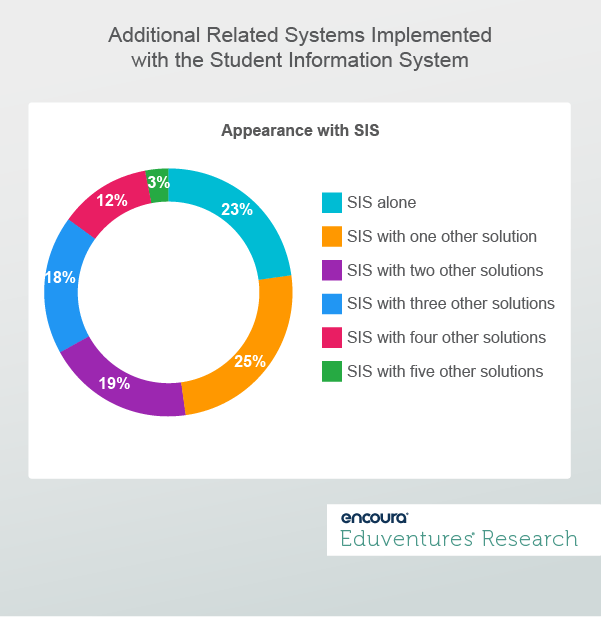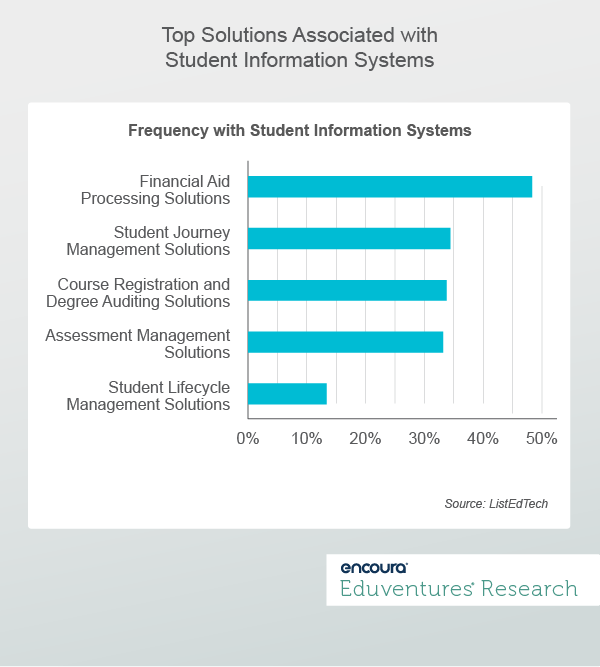June 14-16, 2023
Boston, MA
A commonly held belief is that the enterprise solution is more valuable than the point solution. Indeed, multi-purpose solutions, such as the Student Information System (SIS), can allow schools to simplify their ecosystems by addressing many needs with one system—avoiding complex integrations across solutions that address only one requirement.
This position makes a lot of sense. Yet, if it was always true, then why do so many of us, for example, use both a smartphone (multi-purpose technology) and a watch (single-purpose technology)?
Context
College and university technology ecosystems can be crowded. According to implementation data from ListEdTech and Eduventures’ 2022 Higher Education Technology Landscape Report, the number of solutions within an ecosystem can reach to nearly 1,000 implementations, making the management of software updates, vendor contracts, and integrations across many different systems a challenge.
With a significant and long-standing presence in higher education, the Student Information System often serves as the central source for all student records. Over the years, these systems have increased their offerings to include functionality formerly found only in point solutions, such as Course Registration and Auditing Solutions and Financial Aid Processing Solutions.
Looking to consolidate an ecosystem around the SIS is appealing to many college and university leaders, presenting perhaps the most likely path to overcoming the difficulties in managing complex ecosystems and meeting the needs offered by point solutions. This makes it a good test case for our enterprise-vs.-point solutions question.
The SIS Test Case
Given the appeal of consolidating functionality in enterprise systems like the SIS, we might expect to see most institutions relying solely or mainly on these systems and steering clear of point solutions. But this is not the case.
We looked at five solutions with the most significant functional overlap with the SIS. We found that most institutions have implemented one of these alongside the SIS:
- Financial Aid Processing Solutions
- Assessment Management Solutions
- Course Registration and Degree Auditing Solutions
- Student Lifecycle Management Solutions
- Student Journey Management Solutions
As shown in Figure 1, only 23% of the over 3,630 institutions in our data set, across all sectors (public, private, four-year, two-year, profit, not-for-profit) and of varying sizes, have implemented the SIS alone. The remaining institutions (77%) have also implemented point solutions in segments with the functional overlap alongside the SIS.

We might attribute this to the often-decentralized nature of higher education technology acquisition where different departments purchase technology for their specific needs. Or perhaps some institutions have older versions of SIS that may not include the functionality that overlaps with point solutions and are simply avoiding replacing them.
These explanations may be valid, but they do not support the long-standing belief that enterprise solutions are the better choice than point solutions. While that belief rests on the assumption that a reduction of ecosystem complexity, vendor management challenges, and integration difficulties are the factors tipping the scales toward implementing an enterprise solution, this data shows that other factors drive the decision to acquire point solutions.
By the Numbers
In Figure 1 above, we saw the overall additional related systems implemented with the Student Information System. Figure 2 shows this data at a more granular level. It reveals that Financial Aid Processing Solutions appear alongside SIS the most often (48%), followed by Student Journey Management Solutions (34%), and Course Registration and Degree Auditing Solutions (33%). These solutions appear the most across all technology combinations with the Student Information System.

What should we take away from this analysis? Revisiting the "smartphone and watch" analogy, we see many institutions adding solutions to their ecosystems despite overlapping functionality with Student Information Systems.
We also notice that although it is compelling to see those multi-purpose enterprise technologies as more appealing than point solutions, schools still select point solutions. This selection may perhaps be driven by the expectation of implementation challenges with the SIS, a decentralized acquisition approach, and/or the desire to complement functionality of the SIS.
The Bottom Line
While the “smartphone and watch” analogy is somewhat playful, it reflects the complex factors involved in selecting technology. On one hand, it seems apparent that choosing a single piece of technology that solves many problems over one that solves a single problem makes the most sense. Some may find, however, that they prefer to have both, deciding to forgo the overlapping functionality to take advantage of the additive functionality that the two together bring.
In many cases, the enterprise solution will meet institutional needs, providing an ideal one-stop-shop solution to help leaders support different uses across their institutions without increasing complexity. In other cases, however, the enterprise solution may still fall short of meeting all needs and may result in implementing point solutions.
Therefore, institutions should consider carefully whether they opt for an enterprise solution over a point solution solely out of a desire to reduce complexity and improve convenience.
Likewise, vendors who market their enterprise solutions as the “all in one” solution need to consider that many institutional leaders may not share this goal, and still may elect to supplement their enterprise solutions with point solutions, making the enterprise solution just one of many in their ecosystems. Having insight into the accurate role enterprise solutions play in ecosystems can help inform acquisition decisions and product positioning and illuminate other factors that may need to be in place to support prospective client decision-making.
Never Miss Your Wake-Up Call
Learn more about our team of expert research analysts here.
Eduventures Senior Fellow at Encoura
Contact
Thursday May 6, 2021 at 2PM ET/1PM CT After a historic year, the proven and true recruitment strategies used by enrollment offices nationwide have been challenged. With many high school students now harder to find, how can institutions better evaluate the success of their search results and strengthen their engagement strategies for future years? In this webinar, Eduventures Principal Analyst Kim Reid and ACT | NRCCUA Senior Vice President Clint Chapman will identify what to look for in your funnel right now to improve yield and potential opportunities to strengthen your overall funnel in the years ahead. Sharing research on trends seen throughout institutions this year, we’ll provide practical and effective engagement solutions so that you can meet your students where they are right now, while also building a more sustainable model for the years ahead. Additional topics include:
- Successful funnel strategies and opportunities
- Methods to improve your current yield
- Creating messaging that resonates with students and families
- New methods to engage harder-to-reach students
Eduventures 2022 Higher Education Technology Landscape (Landscape) visualizes 367 vendors and their products, organized into over 44 separate market segments rolled up into four major categories aligned to the student lifecycle.
Throughout the year, we analyze these vendors and products and make that content available to clients. Several vendors have multiple products in their education technology portfolios.
Never Miss Your Wake-Up Call
Learn more about our team of expert research analysts here.

